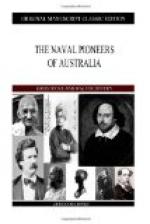Flinders meanwhile had succeeded in reaching the lagoon within the reef, and he and his men jumped out of the boat, and walked to and fro in the shallow water to keep themselves warm and out of the wind; but they sought in vain to discern the lights of the Bridgewater. But the Bridgewater had sailed on to meet another fate. She reached India safely, then left again for England, and was never afterwards heard of. It is difficult to understand how her people could have avoided seeing the others’ distress; it is harder still to believe that, seeing their plight, the Bridgewater’s company could have thus deserted the castaways. Of course, this explanation would have been demanded, but the Bridgewater was an “overdue” ship long before the news of the disaster arrived in England.
As the sun rose, the scene looked less hopeless, and the men found that they were near a small sandbank, on which were a quantity of seabirds’ eggs. Close by were the Porpoise and Cato still holding together on the reef. Returning to the former ship, Flinders at once sent a boat to rescue the exhausted crew of the Cato, who flung themselves into the waves, and were picked up safely.
Then all hands from both wrecks—marvellous to say, only three men were lost during the night—set to work under his directions, and collected all the food and clothing they could possibly obtain. With the warmth of the sun their spirits returned, and the brave fellows took matters merrily enough, many of them decking themselves out in the officers’ uniforms, for their own clothing could not be reached. A landing was soon effected, and a topsail yard was set up as a flagstaff, with the blue ensign upside down, though but little hope was entertained of passing vessels in such a place. In all there were 94 people under Flinders’ care, and they made themselves comfortable in sailcloth tents on the barren sand spit. Enough food had been saved from the Porpoise to last for three months; but to Flinders’ grief many of the papers, charts, and pictures dealing with his explorations were sadly damaged. Among the articles saved was a picture of Government House, Sydney, in 1802, and this and some others are now in the possession of the Royal Colonial Institute, London.
The bank upon which the castaways lived was only 150 fathoms long by 50 broad, and about 3 feet above water. Whilst looking for firewood some of Flinders’ men found an old stern-post of a ship of about 400 tons, which he imagined might have belonged to one of the ships of the La Perouse expedition.
Wearily enough the time passed, and then Flinders determined to attempt to reach Sydney in one of the ship’s boats. He chose a six-oared cutter, and raised her sides with such odd timber as he could find. She was christened The Hope, and on the 26th August he with the commander of the Cato, 12 seamen, and three weeks’ provisions, bade farewell to their comrades, and with a cheer, set out with bold hearts upon their voyage.




